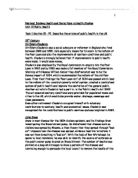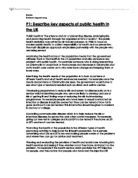The Big stink was a time in the summer of 1854 during which the smell of untreated human waste. John Snow was investigating the drinking water which seemed to spread the Cholera to the people who drank water which was provided by one water company this gave Snow the idea that people who drank the water were more likely to get the disease than those who didn’t drink the water. Snow recognised that all the people who became ill, all received water from a single pump, which drew its supplies from the sewage and contaminated the River Thames. Those who used nearby wells to get water had escaped the infection. Between the cholera and the filthy water was recognised before the bacteriology was able to identify it. After Snow identified the symptoms of the cholera disease he decided to remove the street pumps which stopped the spreading of the cholera disease in certain areas.
The Sanitary Act
As discussed by Stretch John Simon was the third founder of public health. He was involved in supplying several towns to install their first sewage systems during the 1850s and 1860s. In 1866 the Sanitary Act was taken place with the duty of inspecting local authorities and to spread their range of sanitary powers.
In the modern 20th century Beveridge (1879-1963) was often referred to as an architect of the welfare state in Britain. During the 1941 he commissioned by the Prime Minister Winton Churchill, so he could investigate the welfare state schemes of the time and suggests ways of improving them. He developed numerous ideas and principles the effectively led to the welfare which we are familiar with today such as the NHS Act.
This health strategy was released by the new labour government after their election in 1997, the strategy linked with the Acheson report and attempt to tackle the root causes of ill health such as pollution, unemployment, low wages, crime and poor housing. The report of Sir Douglas’s Black in 1980 was the first to highlight these in equalities, followed by the update of ‘The Health Divide’ in 1987. However, the findings were confirmed further in Donald Acheson’s report in 1997. It carries 39 recommendations in which he highlighted three areas which are all policies likely to have an impact on health should be evaluated in terms of their impact on health inequality. The second area is priorities to the health of families with children. The third area steps further should be taken to reduce income inequalities and improve the living standards of poor households this led to Our Healthier Nation which tackled with the causes of ill health including air pollution, unemployment, low wages, crime, disorders and poor housing. It focused on non-communicable diseases such as coronary heart disease, cancer, strokes and mental illnesses.
Today the public health sets out areas with children and young people which took action by 2010, all school in England should have active travels plans. Another campaign was health as a way of life which the NHS life trainers help different individuals to make healthy choices and to stick to them. An example of this is the Sure Start, this campaign help those who didn’t have a reasonable income; they were provided with parenting skills, maternity grant, play groups and midwifery appointments.
The Health Protection Agency is an independent organisation which protects people’s health in the UK. It functions by providing impartial advice and information on health protection. The organisation also provides impartial expert advice on health protection and gives specialist health protection services. It identifies and responds to health hazards and emergencies caused by infections disease, hazardous chemicals, poison or radiation and prepares for potential future threats.
The National Institute for Health and Clinical Excellence is an independent organisation which is responsible for giving guidance on the promotion of good health and prevents and treats of ill health. For example, if you gave bad health it could increase illnesses and disease by not providing the correct medication therefore, the life expectancy will increase. Another example could be redundancy which will make people feel helpless, this leads to people being lazy and relying on benefits if they were cut out. It is also known as N.I.C.E.
M1 – Compare historical & current polices
In the 19th century the Poor Law 1834 was only focused only on those who worked in the workhouse, so those who were poor and unable to get to a workhouse, were unable to receive the support they needed. They faced numerous problems such as the increases of deaths and the widen of diseases. In the 19th century from the politics side didn’t focus on shaping the community. They were more focused on protecting themselves from the cholera disease and letting the poor deal with it. Whereas today the Beveridge Report 1942 helped keep everyone equal and provide people who were sick, unemployed retired or widowed with the required needs they need. This helped reduce the number of deaths over the years and cure certain diseases. The Beveridge Report 1942 focused on helping the community itself politically, this also reduces people from living in poor house and conditions. However, five giant evils identified by William Beveridge remain on the same underlined issues, even if not so extreme.
In the 19th century they mainly focused on communicable disease such as cholera and these were caused by poor lifestyle, not eating healthily or exercising these factors were laughed at thinking they were untrue and weren’t promoted as a positive influence. To cure the communicable disease cost a lot in the 19th century. Whereas today we have free health care and they focus on non-communicable disease such as strokes, HIV and CHD. To prevent people these diseases from increasing they now promote public health to ensure people are living a better and healthier lifestyle.
The first Public Health Act 1848 was aimed to improve the sanitary condition of towns and populous places in England and Wales by placing the supply of water, sewerage, drainage, cleansing and paving under a single local body. Chadwick thought that it would help reduce diseases from spreading. This focused on poverty which relates to the big sting and board street pumps. Today the same kind of system is carried out it is known as the Health Protection, it is includes laws governing health and safety at work or a care setting, food hygiene, usage of tax policy to reduce smoking levels by raising the price of cigarettes. This ensures that everyone is kept safe and helps reduce the number of poverty in UK. Overall, both policies focus on the safety of each individual and faced similar problems with society.








